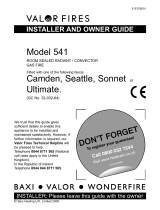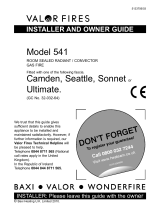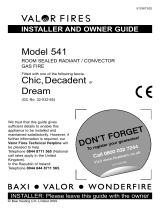
600B731/02
Model BR648 VA
(G.C. 32-032-38)
OWNER’S GUIDE
This guide is intended to help you care for your Wonderfire gas fire. Please read
thoroughly before using and keep for future reference.
We trust that this Guide gives sufficient details to enable the appliance to be operated and
maintained satisfactorily. However, if further information is required, our AdviceLine
will be pleased to help.
Please telephone 0345 626341 (Local call rates apply in the United Kingdom).
In the Republic of Ireland call 353 183 75114.
Please keep this guide in a safe place for future reference
© Wonderfire

OWNER’S GUIDE
Page 2
As supplied, this appliance is for use with natural gas (G20)
When converted using conversion kit no. 591149 this appliance is for use with propane
gas (G31)
This appliance is for use in the United Kingdom (GB) and the Republic of Ireland (IE)
only.
CUSTOMER CARE
Thank you for choosing Wonderfire.
All Wonderfire gas fires are designed to meet the most stringent quality, performance and
safety requirements to provide our customers with many years’ trouble-free service.
Your owner guide aims to improve your understanding and appreciation of your
Wonderfire gas appliance by providing simple and informative instructions to ensure that
you benefit from the excellent performance and features it has to offer.
If you require further assistance or any advice about gas in general, our AdviceLine will be
pleased to help.
Please telephone 0345-626341 (local call rates apply in the United Kingdom).
In the Republic of Ireland please telephone 353 183 75114
LIST OF CONTENTS
SAFETY..................................................................................................................... 3
OPERATING YOUR FIRE.....................................................................................4
CLEANING............................................................................................................... 6
REFITTING COALS............................................................................................... 7
MAINTENANCE......................................................................................................9

OWNER’S GUIDE
Page 3
SAFETY
IF YOU SMELL GAS
DON’T SMOKE
EXTINGUISH ALL NAKED FLAMES
DON’T TURN ELECTRICAL SWITCHES ON OR OFF
TURN OFF THE GAS SUPPLY AT THE METER
OPEN DOORS AND WINDOWS TO GET RID OF THE GAS
IMMEDIATELY CALL THE GAS EMERGENCY SERVICE – SEE YOUR
LOCAL TELEPHONE DIRECTORY
DO
• Have the fire installed by a competent person. In the United Kingdom, installation
must be in accordance with the latest edition of the Gas Safety (installation & use)
Regulations. In the Republic of Ireland, installation must be in accordance with all
national and local regulations in force.
• Have the chimney swept prior to installation if it was previously used for solid fuel.
• Have the fire installed in accordance with the installation instructions
• Provide a minimum clearance of 750mm from the top surface of the hearth to any shelf
made of wood or other combustible material where the shelf is not more than 150mm
deep. For a shelf deeper than 150mm, add 12.5mm to the clearance for every 25mm of
additional shelf depth.
• Always use a fireguard complying with BS6539 or BS6778 for the protection of young
children, the elderly or infirm.
• Wait three minutes before attempting to relight if the fire is switched off or the flames
are extinguished for any reason.
• Get advice about the suitability of any wall covering near your fire. Soft wall coverings
(e.g. embossed vinyl, etc.) which have a raised pattern are easily affected by heat. They
may, therefore, scorch or become discoloured when close to a heating appliance.
Please bear this in mind whenever you are considering redecorating.
• Provide a minimum clearance of 100mm from the outside of the fire case to any corner
wall or other surface. Please bear this in mind if ever you are altering the room.
• DON’T
• Hang clothing, towels or any other fabrics over the fire.
• Throw paper or other materials onto your fire.
• Use the fire with damaged base coals.
• Put more loose coals on the fire than the number given in this guide or use any coals
other than those authorised for this fire. Incorrect combustion could result.
• Attempt to clean or service the fire until it has been switched off and allowed to cool.

OWNER’S GUIDE
Page 4
Figure 1
OPERATING YOUR FIRE
PLEASE NOTE
When operating your fire for the first time, some vapours may be given off which may
cause a slight odour and could possibly set off any smoke alarms in the immediate
vicinity. These vapours are quite normal with new appliances. They are totally harmless
and will disappear after a few hours use.
The Oxysafe flame sensing & flue blockage safety system.
For your safety, this appliance is fitted with a flue blockage safety device which will shut
down the appliance in the event of abnormal flue conditions. This device is NOT a
substitute for an independently mounted Carbon Monoxide detector.
The device will also automatically shut off the gas supply to the fire if the pilot flame
goes out due to lack of oxygen or for any other reason.
If this device starts to repeatedly shut off the gas, get expert advice.
This device incorporates a probe which senses that the heat from the pilot flame is
correct. If this probe is cool, the device will prevent any gas flow unless the control knob
is kept depressed at the “Pilot/Ign” position.
If, for any reason, the flames go out when the fire is hot or if the fire is turned off when
hot, always wait at least three minutes before attempting to relight.
Lighting the pilot
This fire is controlled by a 4-position gas tap mounted on
the front leg of the appliance. In addition to the “Off”
position there is a pilot light and 2 heat control settings.
See figure 1.
• Depress the control knob and turn anticlockwise
towards the “Pilot/Ign” position. A spark should be
generated at the pilot while turning. The spark should
ignite the pilot. The pilot flame can be seen below the
coal at the front left side.
• Keep the button at the “Pilot/Ign” position for a further
ten seconds. This will prevent the flame-sensing device
from shutting off the gas while its probe warms up.
• If the pilot does not ignite instantly, repeat procedure.
If after 10 seconds pilot ignition has not occurred, turn
the control knob back to the “Off” position, wait for 3
minutes and then repeat the ignition procedure.

OWNER’S GUIDE
Page 5
Lighting the Main Burner
• Once the pilot light is established, the main burner can be lit by depressing and
turning the control knob anticlockwise to the “High” position.
Selecting the Heat Setting
• In order to change from one setting to another depress the control knob slightly and
turn the knob to the required position. Any setting from “Low” to “High” may be
selected.
Note: The appliance will operate to its maximum potential if the flue is primed during the
first 20-30 minutes of operation. To do this, simply operate the appliance at its “High”
setting. This will also burn off any carbon deposits that may have formed during previous
operations. If operating the appliance for long periods it is beneficial to change between
settings. This will help to remove any carbon deposits that may form during operation.
Turning the fire back to Pilot Setting
• Depress the control knob and turn clockwise until the pilot setting is reached.
Turning the Appliance Off
• Make sure that the control knob is in the pilot position. Depress the control knob and
turn clockwise to the “Off” position.
• Wait at least three minutes before relighting.

OWNER’S GUIDE
Page 6
CLEANING
To maintain the high performance and quality finish of your Wonderfire appliance,
please follow these guidelines:
• Before attempting to clean the fire, please remember to turn off the fire and wait for
the appliance to cool. The fire will retain heat for some time before cleaning can begin.
• If any pieces of debris are found in the firebox, have the chimney inspected before
further use.
Metal Parts
• Clean the metal parts with a slightly damp cloth and then dry.
• Do not use abrasive cleaners as these will scratch the fire surface.
Ceramic Coals
• Light coatings of soot will usually be burnt off during the normal operation of the fire.
• Should any soot accumulation become excessive, the fuel effect pieces should be
removed from the fire for cleaning.
• This product uses fuel effect pieces containing Refractory Ceramic Fibres (RCF),
which are man-made vitreous silicate fibres. Excessive exposure to this material may
cause temporary irritation to eyes, skin and respiratory tract. Consequently, it makes
sense to take care when handling these articles to ensure that the release of dust is kept to
a minimum.
• Cleaning should be carried out in a well ventilated area or in the open air by gently
brushing with the pieces held away from your face so that you avoid inhaling the dust.
• We do not recommend the use of a normal domestic vacuum cleaner which may blow
dust back into the air.
• We suggest that you remove the coals in the reverse order to that shown in the fuel
bed refitting instructions.
Burner
• The burner surface can be carefully cleaned to remove any loose particles after taking
off the coals. Make sure that no particles are pushed into the burner slots.
Note: Surface cracking of the burner is normal and no cause for concern.

OWNER’S GUIDE
Page 7
Figure 4 Loose Coal Identification
Figure 3 Front Base Coal Position
Figure 2 Rear Base Coal Position
REFITTING COALS
1. Place the rear base coal in the firebox. It should
rest on the ledges at the sides and back of the firebox
and its rear face should touch the firebox rear wall.
See figure 2.
2. Place the front base coal in the firebox with its
bottom front locating over the front rim of the firebox.
Pull the coal forward so that it locates immediately
behind the front rim of the firebox. See figure 3.
3. There are two types of loose coals.
Type “A” coals have a prominent lip. There are
three coals of this type.
Type “B” are squarer than type “A” and have two
grooves on their top surface.
The coals are shown in figure 4. Identify these
coals before attempting to fit them.

OWNER’S GUIDE
Page 8
Figure 9
Figure 8
Figure 7
Figure 6
Figure 5
4. Place a type “A” coal between the
front and rear base coals with its lip
to the front and so that the coal is
close to the left side of the firebox.
See figure 5.
5. Place a type “B” coal between
the front and rear base coals as
shown in figure 6. Its two grooves
should be on the top surface. Its
wide flat end should be at the
back between the left and centre
coals of the rear base coal.
6. Place a type “A” coal between
the front and rear base coals with its
lip to the back and resting against
the centre coal of the rear base coal
as shown in figure 7.
7. Place the remaining type “B”
coal at the right side of the firebox
between the front and rear base
coals. Its two grooves should be
on the top surface with the wide
flat end to the front. The coal
should touch the right side of the
firebox. See figure 8.
8. Place the remaining type “A”
coal between the front and rear
base coals with its lip to the front and
its rear face between the right and
centre coals of the rear base coal.
Angle the coal so that the gap
between it and the type “B” coal to its
right is appreciably larger than the
gap between it and the type “A” coal
to its left but do not have it touching the type “A” coal. This will give the best flame effect.
See figure 9.

OWNER’S GUIDE
Page 9
MAINTENANCE
Regular maintenance
In order to achieve and maintain high levels of personal safety and performance
efficiency, it is essential that the opening at the back of the fire and the flue are kept clear
of any form of obstruction. It is possible that deposits of mortar or soot could fall and
accumulate causing the flue to be blocked or restricted and so preventing proper
clearance of dangerous exhaust fumes.
In the United Kingdom it is the law that a landlord must have any gas appliance, flue and
pipework which is situated in a tenant’s premises checked for safety at least every twelve
months by a competent person (In the U.K, a CORGI registered installer).
We recommend that all gas appliances and their flues, wherever situated, are checked
annually.
Servicing
• In the United Kingdom servicing can be carried out either by a Wonderfire service
engineer or a CORGI registered installer.
• If you require your fire to be serviced, please contact Wonderfire Service on 0121
386 6203 and quote the following details;
a) model name and number.
b) appliance serial no. (To be found on the plate close to the control knob.)
• If you wish to replace any of the owner replaceable parts listed below, please contact
Wonderfire Sales on 0121 386 6295 for your nearest stockist of these parts. When
ordering please quote the part number shown below.
Owner Replaceable Parts
Description Part No
Front base coal 579119
Rear base coal 579129
Pack of 5 loose coals 579149
• When fitting replacement parts, follow the instructions contained in this guide. It
is important that only Wonderfire approved parts are used for maximum safety.
• In the United Kingdom, for general advice about gas and your gas fire call our
ADVICELINE 0345 626 341.
• In the Republic of Ireland call 353 183 75114 for all enquiries.
-
 1
1
-
 2
2
-
 3
3
-
 4
4
-
 5
5
-
 6
6
-
 7
7
-
 8
8
-
 9
9
Wonderfire nexus BR648 VA Owner's manual
- Type
- Owner's manual
- This manual is also suitable for
Ask a question and I''ll find the answer in the document
Finding information in a document is now easier with AI
Related papers
-
Wonderfire Lincoln BR517S Owner's manual
-
Wonderfire sonnet br218 Owner's manual
-
Wonderfire BR265 Owner's manual
-
Wonderfire Marseille BR622 Owner's manual
-
Wonderfire sonnet plus br645 VA Installer's Manual
-
Wonderfire Gasflame 3 Owner's manual
-
Wonderfire BR419 Owner's manual
-
Wonderfire lincoln 5403 Owner's manual
-
Wonderfire 530U PRESIDENT Owner's manual
-
Wonderfire BR00290 SONNET Owner's manual
Other documents
-
Valor BG C-1 Owner's manual
-
Valor Auto Companion Inc. Indoor Fireplace 473 User manual
-
Baxi Fires Division Memphis 7 Operating & Installation Manual
-
Valor 719 Owner's manual
-
Valor 473 Black Beauty Unigas II Unit installation
-
Valor black beauty 466 Owner's manual
-
 Valor Fires 541 Ultimate Installer And Owner Manual
Valor Fires 541 Ultimate Installer And Owner Manual
-
 Valor Fires SEATTLE Installer And Owner Manual
Valor Fires SEATTLE Installer And Owner Manual
-
 Valor Fires 748 User guide
Valor Fires 748 User guide
-
Baxi Fires Division Soraya 746 Owner's manual











